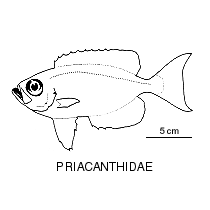- Classification
- ACTINOPTERYGII
- PERCIFORMES
- PRIACANTHIDAE
-
Fish Classification
-
Class
ACTINOPTERYGII Ray-finned fishes -
Order
PERCIFORMES Perches and allies -
Family
PRIACANTHIDAE Bigeyes
Family PRIACANTHIDAE
Common name: Big-eyes, Bigeyes, Deepsea Bullseye
Summary:
Nocturnally actice reef fishes with deep, strongly compressed bodies, very large eyes and a large upturned mouth with a projecting lower jaw.
Bigeyes are nocturnally active, and spend daylight hours in caves. At night they emerge to feed on larger zooplankton such as crab and shrimp larvae, fish larvae, small squids and octopuses, and larval polychaete worms. Many of the species occur in shallow reef habitats, but others range to depths as great as 500 m.
The family occurs in all warm seas and contains four genera with 19 species, all but three of which inhabit the Indo-West Pacific region. In our region there are four species from four genera, two of them circumtropical, one that is also found in Hawaii, and one endemic.
Bigeyes are nocturnally active, and spend daylight hours in caves. At night they emerge to feed on larger zooplankton such as crab and shrimp larvae, fish larvae, small squids and octopuses, and larval polychaete worms. Many of the species occur in shallow reef habitats, but others range to depths as great as 500 m.
The family occurs in all warm seas and contains four genera with 19 species, all but three of which inhabit the Indo-West Pacific region. In our region there are four species from four genera, two of them circumtropical, one that is also found in Hawaii, and one endemic.
Cite this page as:
Dianne J. Bray, Bigeyes, PRIACANTHIDAE in Fishes of Australia, accessed 04 Jul 2025, https://fishesofaustralia.net.au/home/family/112
References
Starnes, W.C. 1988. Revision, phylogeny and biogeographic comments on the circumtropical marine percoid fish family Priacanthidae. Bulletin of Marine Science 43(2): 117-203.
Starnes, W.C. 1999. Family Priacanthidae. pp. 2590-2601 in Carpenter, K.E. & Niem, T.H. (eds). The Living Marine Resources of the Western Central Pacific. FAO Species Identification Guide for Fisheries Purposes. Rome : FAO Vol. 4 pp. 2069-2790.






















































